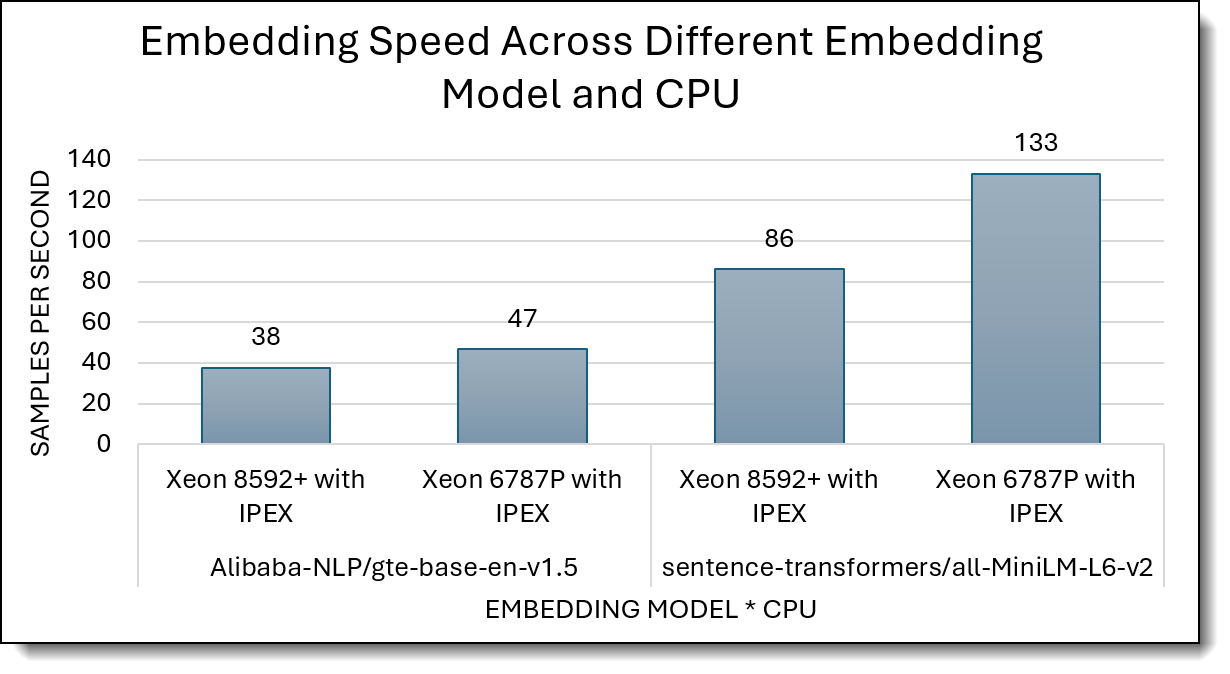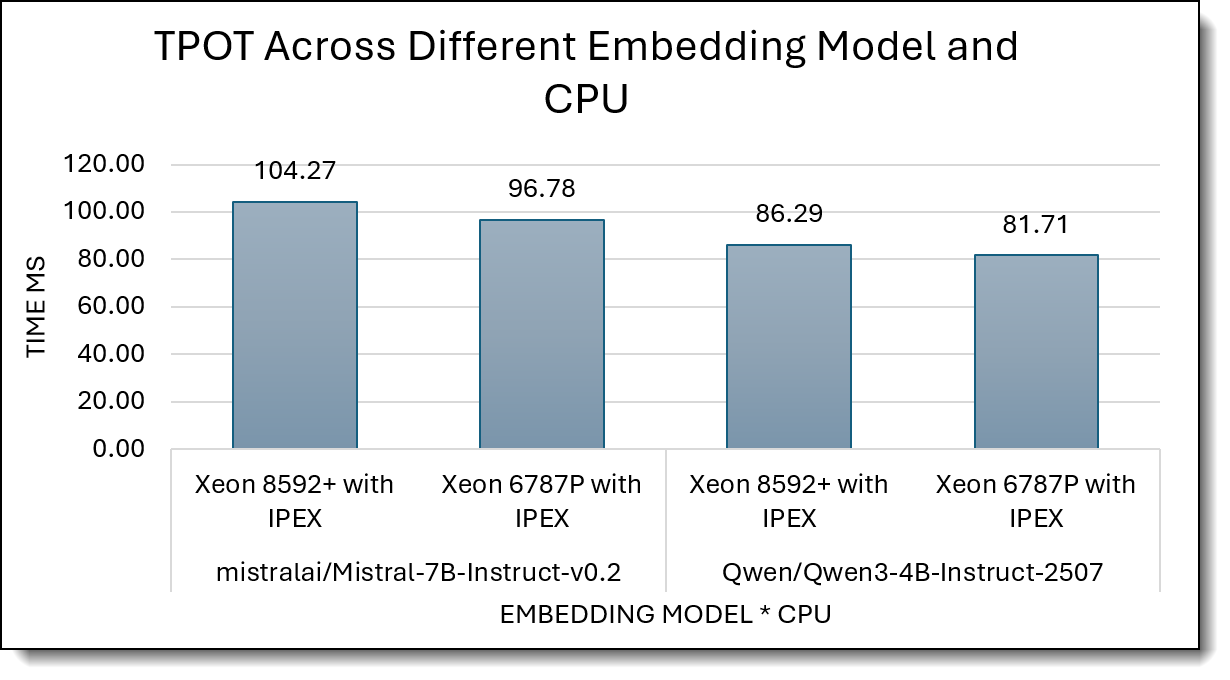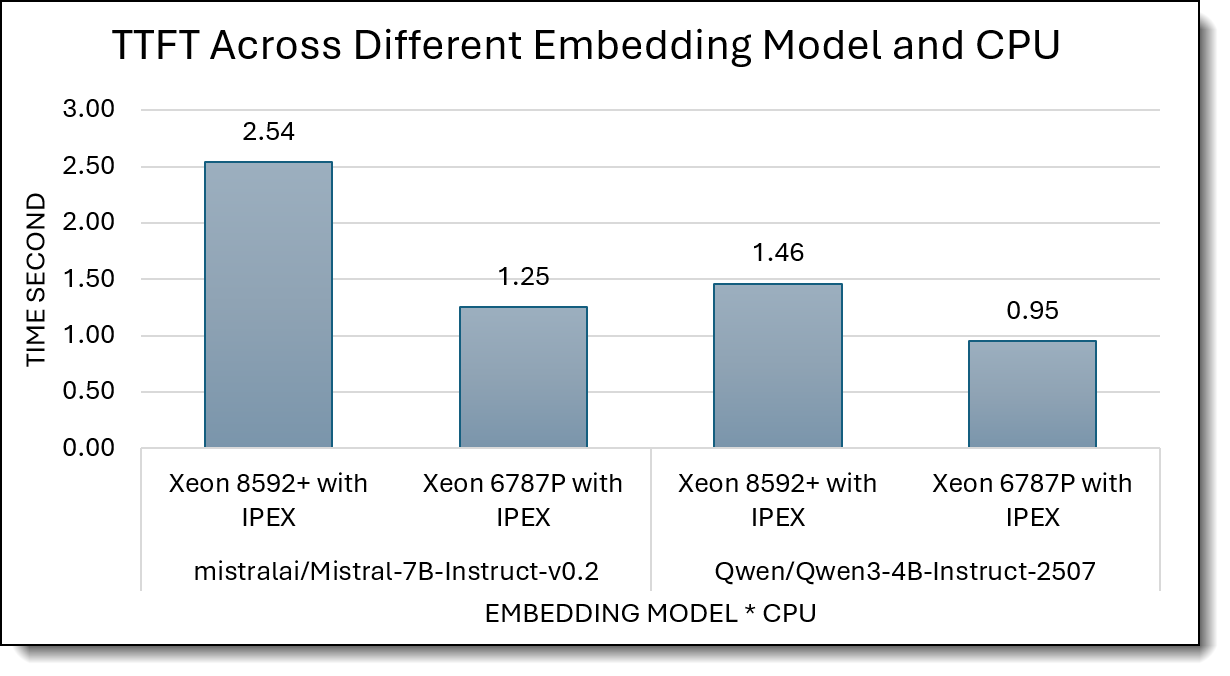Author
Published
6 Nov 2025Form Number
LP2322PDF size
17 pages, 594 KBAbstract
This paper evaluates a standard Retrieval Augmented Generation (RAG) pipeline running entirely on CPUs and optimized for Intel platforms. We benchmark end-to-end performance across embedding throughput, retrieval latency, time to first token (TTFT), and per token generation latency, using a 2×2 matrix of embedding and generative models to reflect realistic deployment choices without overfitting to any single model.
In this analysis, we perform two comparisons: (1) Intel 5th-Gen (8592+) vs AMD EPYC 9554 (4th-Gen) and (2) Gen-over-gen Intel: Xeon 6th-Gen (6787P) vs 5th-Gen (8592+). Our measurements show a clear gen-over-gen uplift with 6th Gen Intel (6787P). With Intel Extension for Pytorch, Intel CPU advantages over AMD EPYC 9554 across embedding throughput, retrieval latency, TTFT, and per token generation, enabling CPU first RAG that meets stringent SLAs without accelerators.
The target audience includes the following:
- AI/ML engineers & platform teams evaluating CPU first or CPU preferred RAG deployments who need defensible latency/throughput numbers and reproducible test methodology.
- IT architects & procurement weighing TCO, capacity planning, and on-prem compliance benefits of Xeon based RAG.
- Business stakeholders seeking practical guidance on where CPU only or CPU primary RAG can deliver the best cost performance and time to value without compromising interactive user experience.
Introduction
Retrieval Augmented Generation (RAG) pairs an LLM with a search/retrieval layer so answers are grounded in external knowledge, reducing hallucinations and keeping responses current for knowledge intensive tasks.

Figure 1. Retrieval-Augmented Generation framework
RAG now underpins common enterprise use cases such as internal search, customer support, and analytics on major platforms (e.g., Azure AI Search, Google Cloud Vertex AI RAG), reflecting broad industry adoption.
With this paper, you’ll have a reproducible CPU-first benchmarking baseline for standard RAG, To ensure fairness, we present two comparisons:
- A gen-over-gen Intel comparison, Xeon 6th-Gen vs 5th-Gen
- A cross-vendor baseline, Intel 5th-Gen 8592+ vs AMD EPYC 9554
Evaluation Metrics & Model Selection
This section defines the performance metrics used to assess a standard RAG pipeline (embedding throughput, retrieval latency, TTFT, and per-token generation) and explains why each matter for production. It then lays out our 2×2 model matrix (embedding × generator) and the selection criteria, followed by the dataset, chunking, retrieval-k, and inference settings to ensure fair, reproducible comparisons across platforms.
We implemented the RAG pipeline in Python 3.10, using LangChain for orchestration and Chroma as the vector database.
The pipeline comprises of three components:
- Document preprocessing and chunking
- Dense embedding + ANN search in Chroma
- Instruction-tuned LLM generation
Measurements (TTFT/TPOT/retrieval) are runtime-agnostic and reproducible with any CPU inference backend.
In this section:
System performance metrics
We focus on metrics that matter for production RAG:
- Embedding Portion:
- Embedding Throughput (documents/sec or samples/sec): higher is better.
- Retrieval Latency (ms): time for content search; lower is better.
- Generation Portion
- TTFT (Time to First Token) (s): interactive latency; lower is better.
- TPOT(Time Per Output Token) (ms): average time to generate each individual output token after first token, also known as inter-token latency; lower is better.
Notes on interpretation: TTFT governs perceived responsiveness; per-token latency dominates long responses; embedding throughput and retrieval latency dominate indexing and high-QPS workloads.
Models
We evaluate a 2×2 matrix combining two embedding encoders with two instruction-tuned LLMs, selected for wide adoption and CPU-friendliness; full model cards are listed in Resources.
- Embedding Models
- Alibaba-NLP/gte-base-en-v1.5 (768-d dense encoder).
- sentence-transformers/all-MiniLM-L6-v2 (384-d; fast, widely adopted).
- Generative Models
- Mistral-7B-Instruct-v0.2 (7B, strong generalist).
- Qwen3-4B-Instruct-2507 (compact 4B, latency-friendly).
For more information about these models, see the links in the Resources section.
Dataset
To exercise realistic enterprise lookups, we use a focused documentation corpus with controlled crawl depth and deterministic chunking, enabling repeatable retrieval and generation profiles.
Hugging Face documentation: Five well-known areas of Hugging Face usage. A key parameter here is max_depth, which controls how deeply we crawl from the starting page
# Define the documentation sections to scrape, with varying crawl depths.
urls_to_load = [
{"url": "https://huggingface.co/docs/transformers/index", "max_depth": 2},
{"url": "https://huggingface.co/docs/datasets/index", "max_depth": 2},
{"url": "https://huggingface.co/docs/tokenizers/index", "max_depth": 1},
{"url": "https://huggingface.co/docs/peft/index", "max_depth": 1},
{"url": "https://huggingface.co/docs/accelerate/index", "max_depth": 1}
]
Performance Results & Analysis
In this section, we present side-by-side results for the standard RAG pipeline: embedding throughput, retrieval latency, time-to-first-token, and per-token generation. Results are broken down by workload and platform, emphasizing gen-over-gen uplift on 6th Gen vs 5th Gen Intel Xeon, and the comparison of Xeon 5th Gen to AMD EPYC with practical takeaways for SLAs and capacity planning.
Embedding Throughput
The figures below show the embedding throughput across models and CPUs. Higher values indicate faster embedding speed.
Intel Xeon 8592+ VS AMD 9554
Figure 2 shows embedding throughput (samples/sec) for two embedding models on AMD EPYC 9554, Intel Xeon 8592+, and Xeon 8592+ with IPEX..
For gte-base-en-v1.5, Xeon 8592+ already beats EPYC 9554 (23 vs 8 samples/s), and Xeon 8592+ with IPEX jumps to 38 samples/s, roughly 4.7× AMD and 1.6× over vanilla Xeon. For MiniLM-L6-v2, EPYC 9554 is slightly ahead of stock Xeon (58 vs 50 samples/s), but Xeon 8592+ with IPEX reaches 86 samples/s, about 1.5× AMD and 1.7× standard Xeon—showing that IPEX consistently lifts Xeon’s embedding throughput.
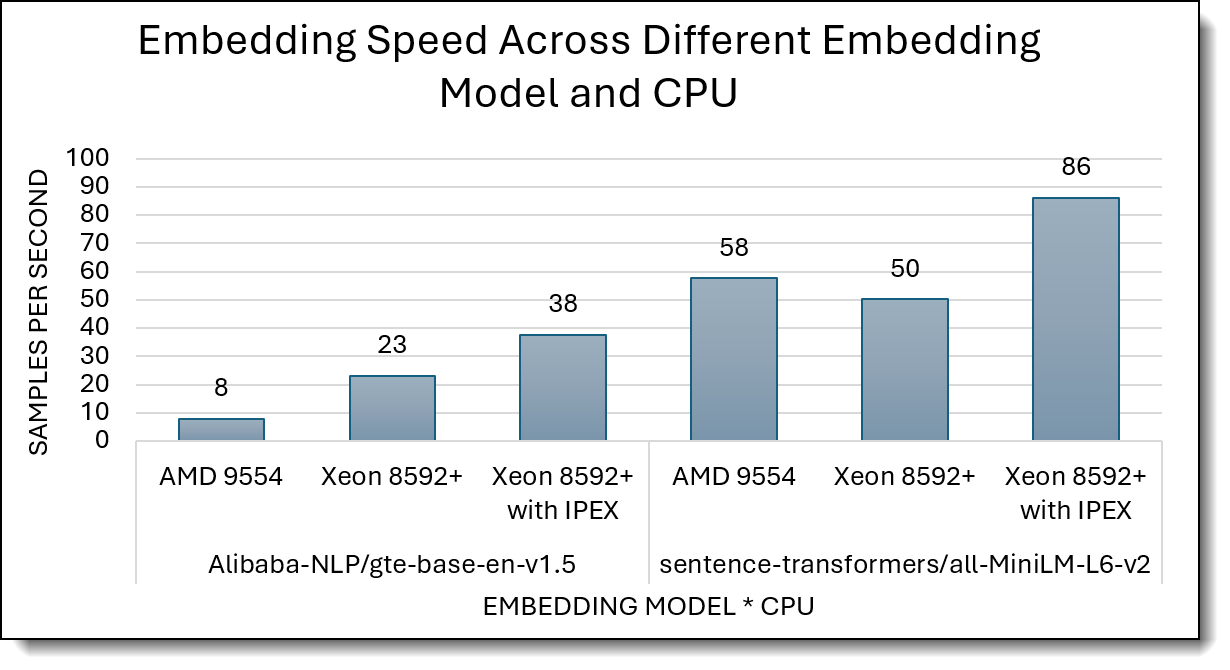
Figure 2. Embedding Throughput (higher is better)
Intel Xeon 6787P VS Intel Xeon 8592+
Figure 3 compares embedding throughput (samples/sec) for Xeon 8592+ with IPEX vs Xeon 6787P with IPEX across two embedding models.
On both embedding models, crucially the 6th-Gen Xeon delivers a measurable uplift versus the 5th-Gen Xeon, generation over generation, adding about 23% more throughput on GTE (47 vs 38) and about 54% on MiniLM (133 vs 86), confirming a consistent uplift across encoders.
Embedding Retrieval
The figures below show the speed of documents retrieval across models and CPUs. Lower values indicate faster retrieval.
Intel Xeon 8592+ VS AMD 9554
Figure 4 shows retrieval latency (ms, lower is better) for AMD 9554 vs Intel Xeon 8592+ with and without IPEX, across two embedding models.
For gte-base-en-v1.5, Xeon 8592+ cuts latency from 52.9 ms on AMD to 19.9 ms, and Xeon 8592+ with IPEX further reduces it to 15.2 ms. That’s about a 3.5× improvement over AMD. For MiniLM-L6-v2, AMD sits at 20.6 ms, stock Xeon is slightly slower at 25.5 ms, but Xeon 8592+ with IPEX again becomes the fastest at 14.2 ms, clearly outperforming both.
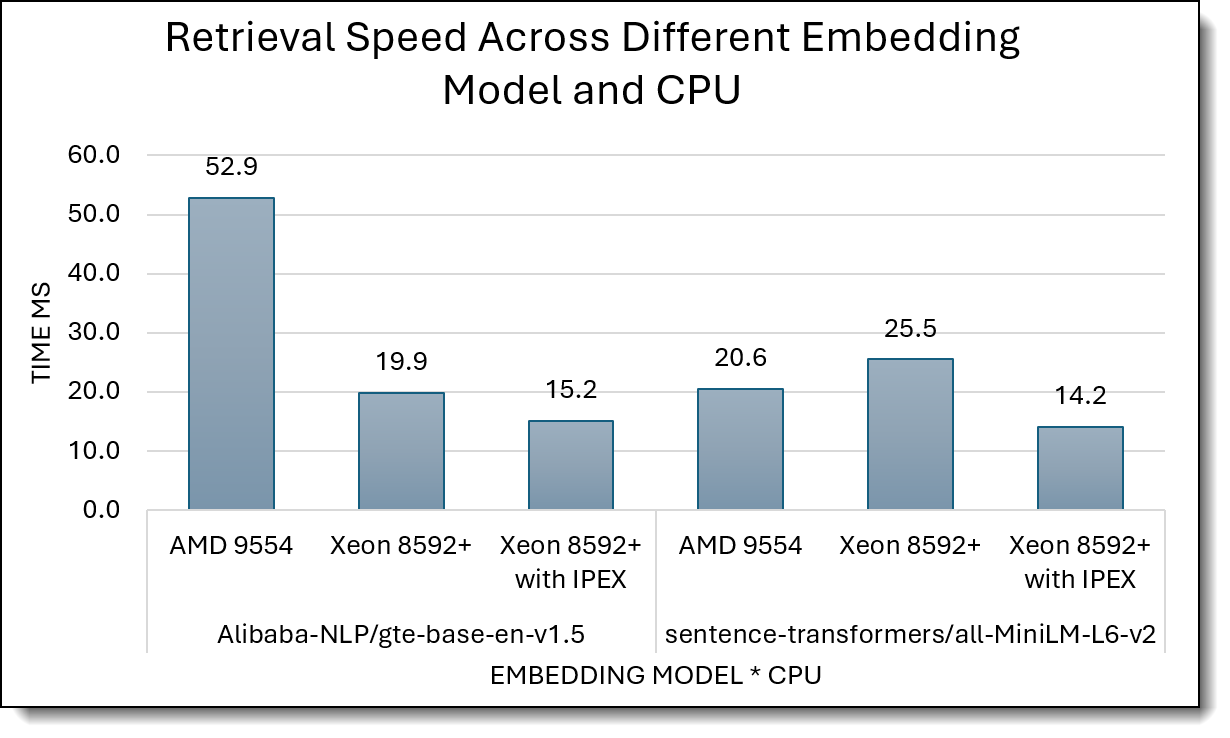
Figure 4. Retrieval Latency (lower is better)
Intel Xeon 6787P VS Intel Xeon 8592+
Figure 5 compares retrieval latency (ms, lower is better) for Xeon 8592+ with IPEX vs Xeon 6787P with IPEX across two embedding models.
For gte-base-en-v1.5, retrieval drops slightly from 15.2 ms on 8592+ to 14.8 ms on 6787P about 3% improvement. For MiniLM-L6-v2, latency improves from 14.2 ms to 13.8 ms. Overall, Xeon 6787P with IPEX is consistently but modestly faster than Xeon 8592+ with IPEX for retrieval in both models.
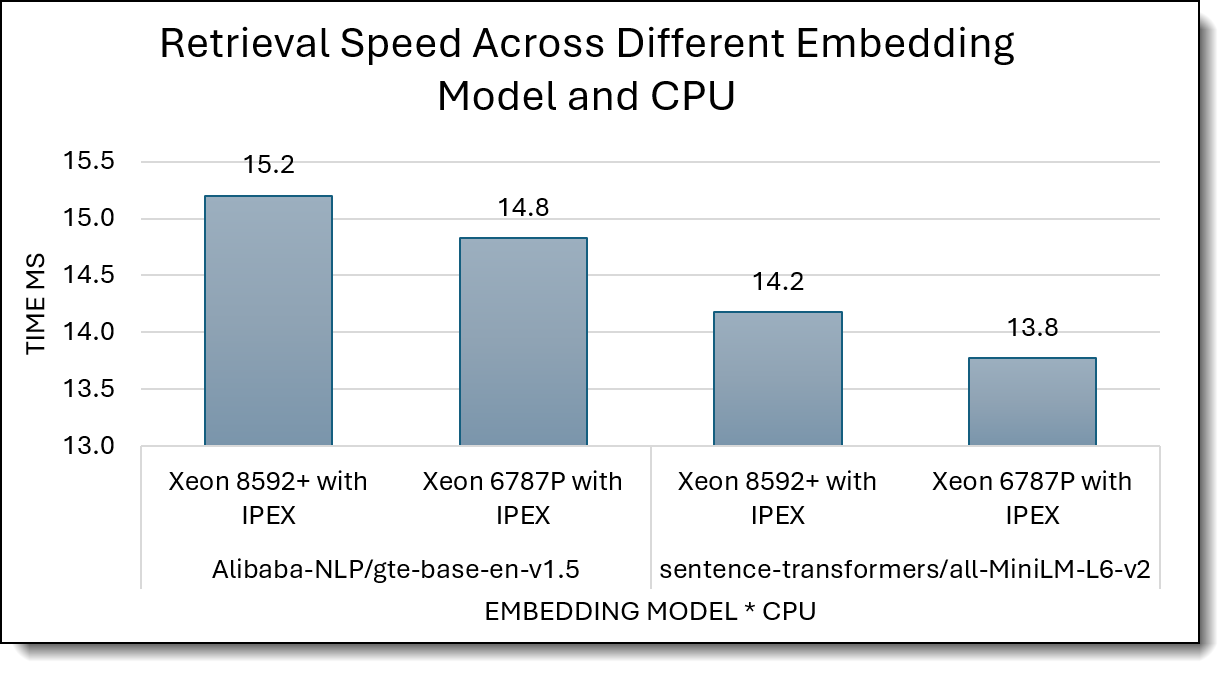
Figure 5. Retrieval Latency (lower is better)
Generation Latency – TPOT
The figures below show Time per Output Token (TPOT) across generative model and CPUs. Lower values indicate faster streaming once the first token appears.
Intel Xeon 8592+ VS AMD 9554
Figure 6 reports TPOT (time per output token, ms; lower is better) for Mistral-7B and Qwen3-4B across AMD 9554, Xeon 8592+, and Xeon 8592+ with IPEX.
For Mistral-7B, AMD (313 ms) is better than stock Xeon (398 ms), but Xeon 8592+ with IPEX again leads with 104 ms, about 3× faster than AMD. For Qwen3-4B, AMD and Xeon are similar (283 ms vs 317 ms), while Xeon 8592+ with IPEX drops TPOT to 86 ms, roughly 3.3× faster than AMD, which makes the Xeon+IPEX setup clearly best for streaming speed.

Figure 6. Time per Output Token (Lower is better)
Intel Xeon 6787P VS Intel Xeon 8592+
Figure 7 reports TPOT (time per output token, ms; lower is better) for Xeon 8592+ with IPEX and Xeon 6787P with IPEX on two LLMs.
For Mistral-7B-Instruct-v0.2, TPOT drops from 104.27 ms on 8592+ to 96.78 ms on 6787P; for Qwen3-4B-Instruct-2507, it improves from 86.29 ms to 81.71 ms. Overall, Xeon 6787P with IPEX consistently streams tokens a bit faster (roughly 5–7% lower TPOT) than Xeon 8592+ with IPEX for both models.
Generation Latency – TTFT
The figures below show Time to First Token (TTFT) across generative models and CPUs. Lower values improve perceived responsiveness, aligning with the near 1-second interaction threshold for fluid UX.
Intel Xeon 8592+ VS AMD 9554
Figure 8 shows TTFT (time to first token, seconds; lower is better) for Mistral-7B and Qwen3-4B across AMD 9554, Xeon 8592+, and Xeon 8592+ with IPEX.
For Mistral-7B, AMD and stock Xeon are similar (3.58 s vs 4.14 s), but Xeon 8592+ with IPEX drops TTFT to 2.54 s, drops 30% in TPOT, clearly the fastest. For Qwen3-4B, AMD is slightly better than stock Xeon (2.95 s vs 3.26 s), while Xeon 8592+ with IPEX again leads with a much lower TTFT of 1.46 s, roughly 50% drop.
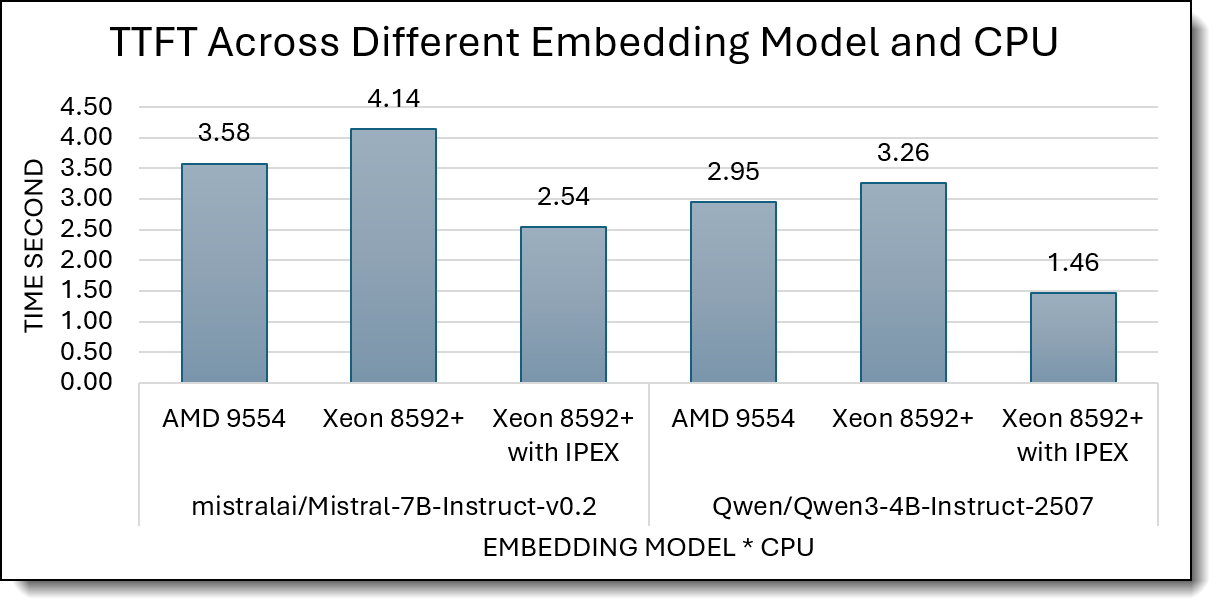
Figure 8. Time to First Token (Lower is better)
Intel Xeon 6787P VS Intel Xeon 8592+
Figure 9 compares TTFT (time to first token, seconds; lower is better) for Xeon 8592+ with IPEX vs Xeon 6787P with IPEX on two LLMs.
For Mistral-7B-Instruct-v0.2, TTFT drops from 2.54 s on Xeon 8592+ to 1.25 s on Xeon 6787P, about a 2× improvement. For Qwen3-4B-Instruct-2507, TTFT improves from 1.46 s to 0.95 s, roughly a 35% reduction. Overall, Xeon 6787P with IPEX consistently delivers much faster first-token times and translating to earlier response onset and snappier UX in interactive RAG.
Conclusion and Business Impact
The results described in the previous section show that Intel Xeon (6787P) delivers meaningful, measurable gains over its predecessor and EPYC 9554 for the entire RAG pipeline:
- 05-1.5× improvement in embedding throughput on common encoders.
- Up to 3× faster retrieval.
- Up to 3x faster per-token generation and 1.3 - 2× better TTFT.
These gains compound across solid RAG services to:
Interactive Chat / Support (streaming UI)
Table 1 converts TTFT/TPOT + retrieval into end-to-end totals time for generating 100- and 200-token replies, useful for SLA mapping in chat/support.
Doc QA / Analyst Copilots (heavier answers)
Table 2 shows totals time for generating 300/400 tokens, matching analyst/copilot usage where answers are longer.
Based on our measurements, Intel Xeon 6th-Gen (6787P) shows consistent generation-over-generation gains over 5th-Gen (8592+). These results indicate that CPU-first RAG is viable on Xeon 6 for the tested model sizes and workloads.
- TTFT (time to first token):
- On Xeon 6787P, Qwen-4B reaches 0.97 s and Mistral-7B 1.25 s.
- Per Nielsen Norman Group’s interaction thresholds, within 1 second keeps users “in flow” and within 10 seconds risks loss of attention. Your Qwen-4B TTFT meets the 1 s ideal, and Mistral-7B is just over but still well within an acceptable range for an interactive chat UX.
- TPOT (per-token generation speed):
- On 6787P you measured 86–88 ms/token, i.e.,11–12 tokens/second. For English, a token is roughly ¾ of a word (4 characters), so 11 tokens/s corresponds to about 8–12 words/s in practice. That is above typical on screen reading speeds (200–300 wpm = 3–5 words/s), so the stream should feel comfortably fast to users.
Based on our end-to-end benchmarks, 6th Gen Intel Xeon 6787P offers a clear gen-over-gen uplift versus the 5th Gen Intel Xeon CPU across the RAG pipeline; it delivers acceptable TTFT (0.97–1.25 s) and streaming speeds (86–88 ms/token ≈ 11 tokens/s) that keep interactive chat and doc-QA responsive. Combined with its strong retrieval/embedding performance, Xeon 6 enables CPU first RAG that meets mainstream UX SLOs without accelerators for the tested model sizes.
Future Work
This paper is Part 1 of 3 of a series of papers on Retrieval Augmented Generation.
Future work planned is as follows:
- Part II: Multimodal RAG: extend the standard pipeline to support cross-modal retrieval and grounding (e.g., text with images/tables/code), compare hybrid indexes and multimodal encoders/LLMs, and quantify modality-aware latency and throughput alongside retrieval quality.
- Part III: Agentic Long-Context RAG: introduce planning and tool use with validation loops (self-check, re-query, re-rank), add long-context memory, and evaluate end-to-end task success, stability across multi-step trajectories, and cost–latency trade-offs.
System Configurations
The following table lists the configuations of the systems under test.
Resources
For more information, see these resources:
- Lewis et al. “Retrieval-Augmented Generation for Knowledge-Intensive NLP.” arXiv:2005.11401
https://arxiv.org/abs/2005.11401 - Intel Extension for PyTorch:
https://intel.github.io/intel-extension-for-pytorch/ - Intel Advanced Matrix Extensions (Intel AMX):
https://www.intel.com/content/www/us/en/products/docs/accelerator-engines/what-is-intel-amx.html - Intel Xeon 6787P (Intel Xeon 6 / Granite Rapids) product page:
https://www.intel.com/content/www/us/en/products/sku/241844/intel-xeon-6787p-processor-336m-cache-2-00-ghz/specifications.html - UX response-time thresholds (≈0.1 s instant / ≈1 s flow / ≈10 s attention): Nielsen Norman Group
https://www.nngroup.com/articles/response-times-3-important-limits/ - Average adult silent reading speed (200–300 wpm):
https://en.wikipedia.org/wiki/Words_per_minute
Model cards:
- sentence-transformers/all-MiniLM-L6-v2
https://huggingface.co/sentence-transformers/all-MiniLM-L6-v2 - Alibaba-NLP/gte-base-en-v1.5
https://huggingface.co/Alibaba-NLP/gte-base-en-v1.5 - Mistral-7B-Instruct-v0.2
https://huggingface.co/mistralai/Mistral-7B-Instruct-v0.2 - Qwen3-4B-Instruct-2507
https://huggingface.co/Qwen/Qwen3-4B-Instruct-2507
Author
Kelvin He is an AI Data Scientist at Lenovo. He is a seasoned AI and data science professional specializing in building machine learning frameworks and AI-driven solutions. Kelvin is experienced in leading end-to-end model development, with a focus on turning business challenges into data-driven strategies. He is passionate about AI benchmarks, optimization techniques, and LLM applications, enabling businesses to make informed technology decisions.
Trademarks
Lenovo and the Lenovo logo are trademarks or registered trademarks of Lenovo in the United States, other countries, or both. A current list of Lenovo trademarks is available on the Web at https://www.lenovo.com/us/en/legal/copytrade/.
The following terms are trademarks of Lenovo in the United States, other countries, or both:
Lenovo®
ThinkSystem®
The following terms are trademarks of other companies:
AMD and AMD EPYC™ are trademarks of Advanced Micro Devices, Inc.
Intel®, the Intel logo and Xeon® are trademarks of Intel Corporation or its subsidiaries.
Linux® is the trademark of Linus Torvalds in the U.S. and other countries.
Azure® is a trademark of Microsoft Corporation in the United States, other countries, or both.
Other company, product, or service names may be trademarks or service marks of others.
Configure and Buy
Full Change History
Course Detail
Employees Only Content
The content in this document with a is only visible to employees who are logged in. Logon using your Lenovo ITcode and password via Lenovo single-signon (SSO).
The author of the document has determined that this content is classified as Lenovo Internal and should not be normally be made available to people who are not employees or contractors. This includes partners, customers, and competitors. The reasons may vary and you should reach out to the authors of the document for clarification, if needed. Be cautious about sharing this content with others as it may contain sensitive information.
Any visitor to the Lenovo Press web site who is not logged on will not be able to see this employee-only content. This content is excluded from search engine indexes and will not appear in any search results.
For all users, including logged-in employees, this employee-only content does not appear in the PDF version of this document.
This functionality is cookie based. The web site will normally remember your login state between browser sessions, however, if you clear cookies at the end of a session or work in an Incognito/Private browser window, then you will need to log in each time.
If you have any questions about this feature of the Lenovo Press web, please email David Watts at [email protected].

